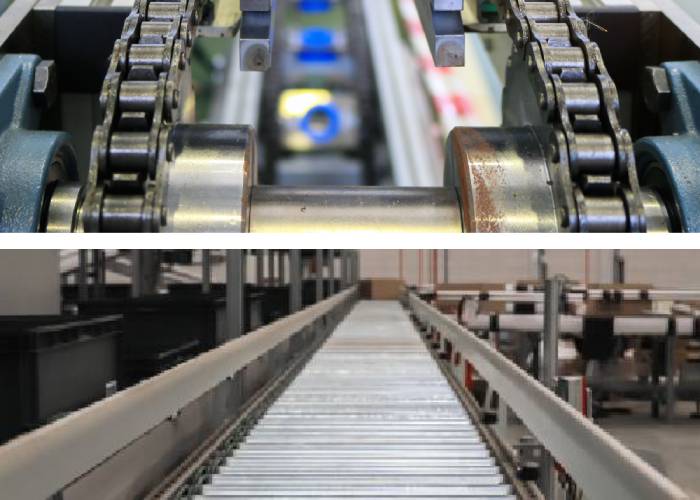

The right conveyor system can significantly impact the overall workflow. The right choice can improve productivity and reduce downtime. In contrast, a poorly chosen one can result in downtime.
Both Chain conveyors and Roller conveyors have unique strengths, suitable for different applications. Find the intricacies of these two conveyor types, to make informed decisions for your faculty.
Understanding Chain Conveyor System
Chain conveyors work as interconnected links to transport products along a defined path. Their robust nature makes them ideal for handling heavy loads. Key components of a chain conveyor system include:
- Chains are the driving force, typically made of steel or plastic
- Sprockets are engaged with the chain to power the system
- Idlers support the chain and maintain tension
How does it work?
The working principle of chain conveyors is simple. Motors drive the chains, carrying the load along the conveyor path as they move. The chains are typically mounted on a series of sprockets which move continuously, holding the materials along the path.
Advantages of Chain Conveyors
- Chain conveyors can handle hefty loads. This makes them ideal for lifting heavy products.
- The chains are highly durable.
- Chain conveyors can be customized.
- These conveyors provide precise control over the movement of materials. This is crucial in industries like automotive manufacturing.
Understanding Roller Conveyor System
Roller conveyors help move materials in the production unit from one point to another. They are available in various designs and styles. They’re found in diverse applications, such as warehouses, supermarkets, airports, chemical industry, pharmaceutical industry, etc.
How does it work?
Roller Conveyors are either powered or unpowered. Powered ones are driven by motors. They are arranged in a straight line or curved to fit the layout of the production facility. They can reduce product inertia at higher speeds, which makes it useful when placed after high-speed sorting equipment.
Advantages of Roller Conveyors
- Roller conveyors are used in various applications. They vary from moving light items to handling heavier loads.
- Roller conveyors typically require less maintenance.
- Roller conveyors provide a safer workplace as they can reduce accidents.
- They do not require motors or electricity to operate, making it energy efficient.
A Comparative Analysis
| Feature | Chain Conveyors | Roller Conveyors |
| Load Capacity | High | Medium |
| Durability | High | Medium |
| Maintenance | Moderate | Low |
| Noise | High | Low |
| Cost | High | Low |
| Product Handling | Rough | Gentle |
| Inclines | Efficient | Less Efficient |
Factors Influencing the Choice
When deciding between the two, several factors must be considered as per your needs. Here are some key considerations:
Product weight, size, shape, and fragility are a few defining factors.
Additionally, the production environment, including temperature, humidity, and cleanliness requirements, play a role. Other critical factors include desired production rate, budgetary constraints, and available floor space.
When to Choose Chain Conveyors:
Chain conveyors excel in specific applications. They are ideal for handling heavy or bulky items, operating in harsh environments with extreme conditions. Industries requiring high-capacity production lines often benefit from the durability of chain conveyors.
When to Choose Roller Conveyors:
Roller conveyors are well-suited for different operational needs. They are preferred for handling light to medium-weight products. Especially when a product’s fragility is at stake. Their lower cost makes them a perfect choice for budget-conscious projects.
Conclusion
The decision between chain and roller conveyors cannot be a single solution approach. A comprehensive evaluation of products and production environment must be done to conclude. Operational requirements are essential to select the most suitable system. By carefully considering these factors, businesses can optimize material handling.
To get in-depth insights, visit our website, www.automagindia.com.
ALSO READ
Understanding the Functions of Roller Conveyors
How Roller Conveyors Drive the Automotive Industry
Friction Conveyor vs Roller Conveyor: Key Differences and Applications
The Benefits of Partnering with a Reliable Roller Conveyor Supplier


